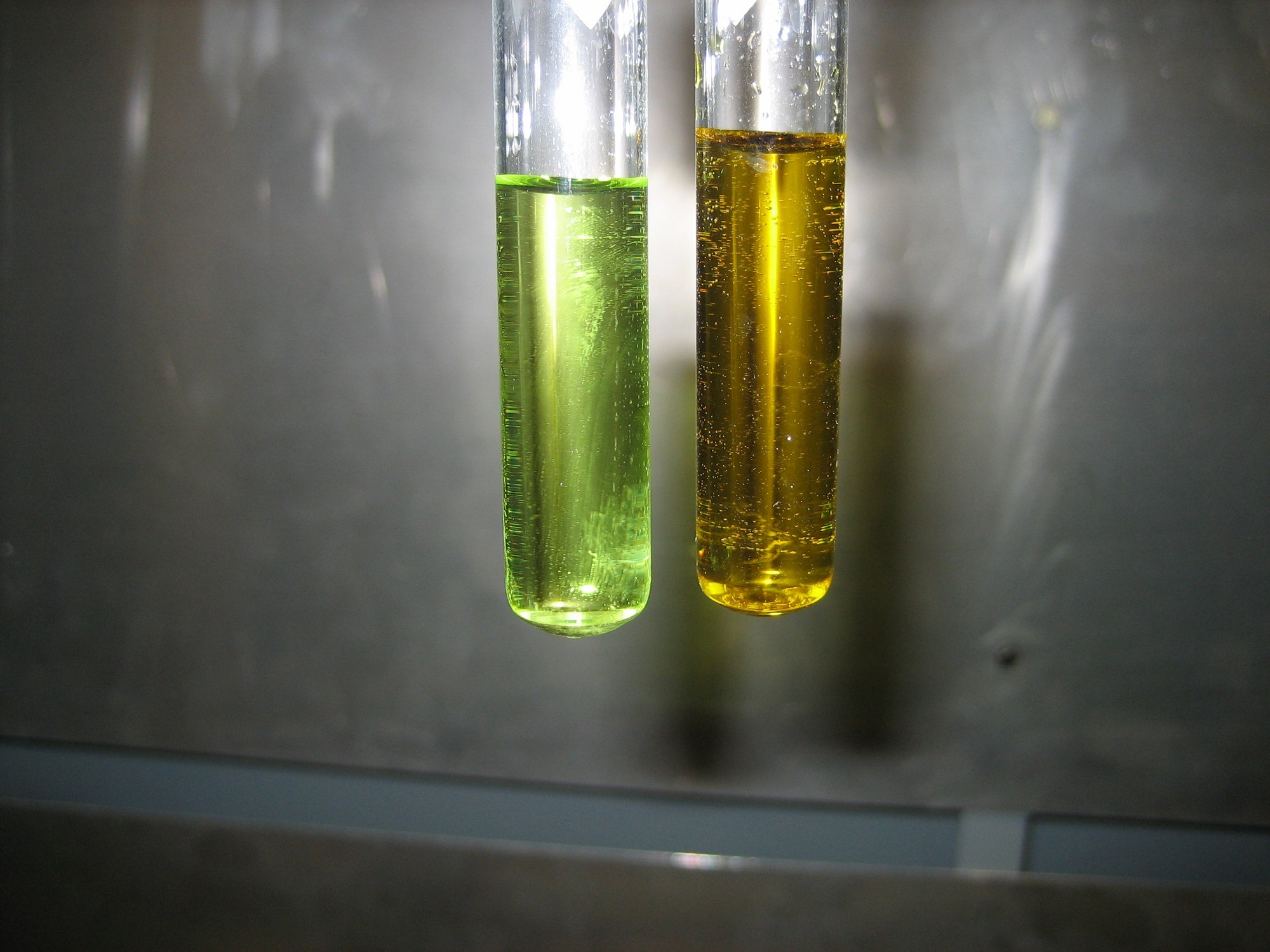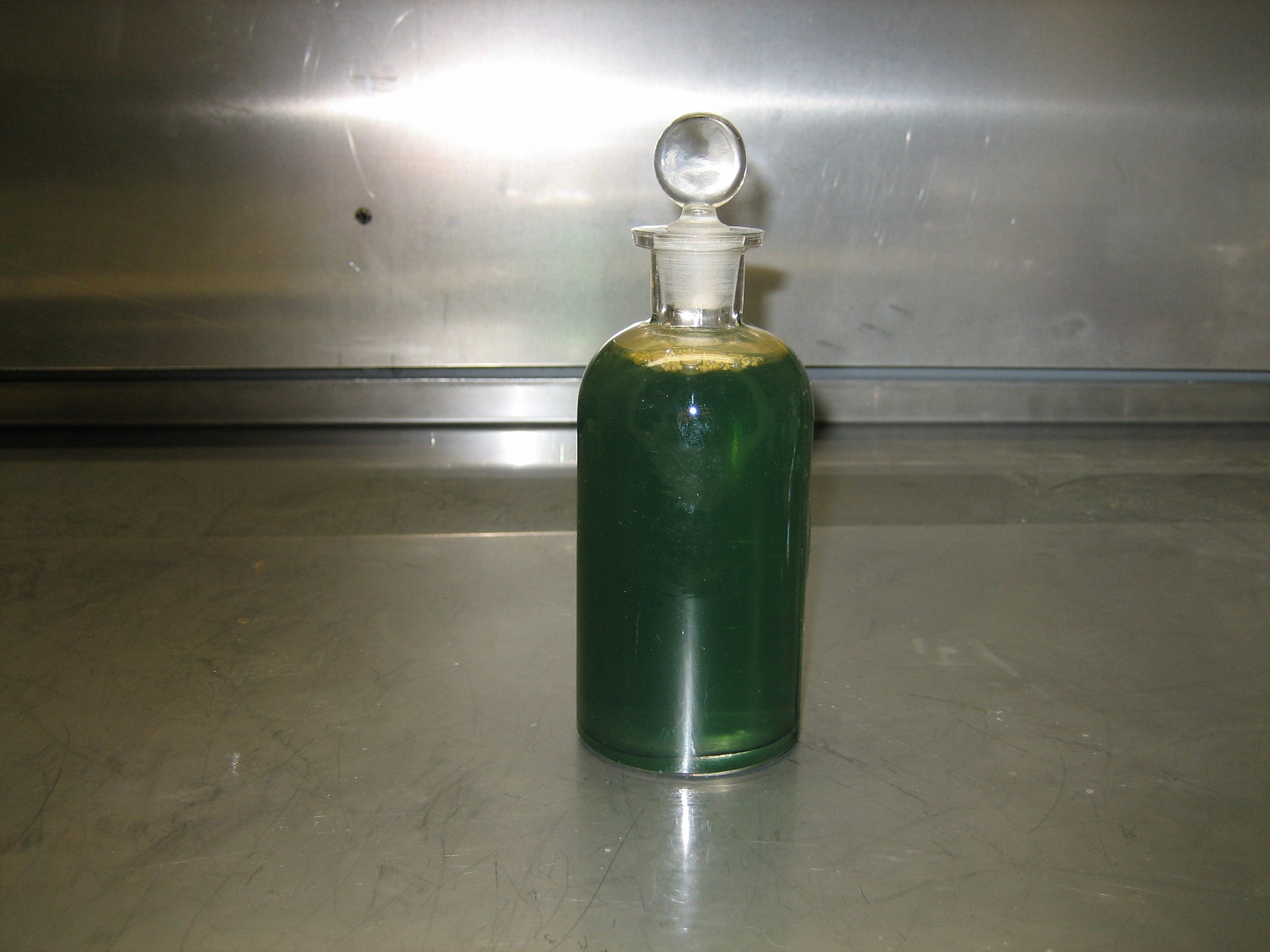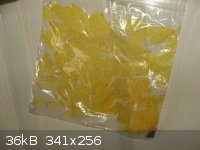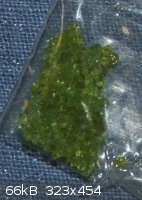| Pages:
1
2 |
The_Simpsons
Harmless

Posts: 15
Registered: 17-7-2005
Location: Falun, Sweden
Member Is Offline
Mood: No Mood
|
|
FeCl2
what is the simplest way to extract the iron(II) chloride from hydrochloric acid with household materials? I've tried filtering it, didn't
work ( at least not with the filter i used), some other methods? so how to extract the green iron chloride solved or wellmixed in my bottle with a 35%
solution of hydrochloric acid(35% before i put the iron)?
|
|
|
hydrargirum
Harmless

Posts: 19
Registered: 14-6-2005
Location: chile
Member Is Offline
Mood: No Mood
|
|
If it dissolved sufficient iron until there is not more loosening of H2 (excess of Fe) it obtains by filtration clear a green liquid ,that there is to
evaporate by heating until begins has to form a crystalline crust in the surface, then adds drops of concentrated HCl and I continued warming up
revolving with a glass rod until taking a sample with the rod and letting cool solidify. To let itself cool the rest it will crystallize.
|
|
|
hydrargirum
Harmless

Posts: 19
Registered: 14-6-2005
Location: chile
Member Is Offline
Mood: No Mood
|
|
Specification:
Drops of HCl are enough 2 o3; not more.
|
|
|
pyrochem
Harmless

Posts: 21
Registered: 1-1-2006
Location: United States
Member Is Offline
Mood: No Mood
|
|
Try boiling the solution (outside). The water and hydrogen chloride should boil off, leaving FeCl2 behind. There may be a problem with FeCl2
oxidizing in air.
|
|
|
woelen
Super Administrator
        
Posts: 8082
Registered: 20-8-2005
Location: Netherlands
Member Is Offline
Mood: interested
|
|
FeCl2 cannot that easily be isolated without oxidation. You get FeCl2.4H2O. I have done an experiment of dissolving quite some iron in conc. HCl and
then leaving the test tube with the solution, stoppered for a few days, such that no oxygen could get in. The result was really stunning. I obtained a
beautiful crystal of approximately 1 cm diameter.
As soon as I took the crystals out of the test tube, the color changed from blue/green to green. Pictures of the crystal can be found below. The
second picture has a little square, which shows the color of the crystal, before it was exposed to air. Unfortunately I did not have the time to make
the picture of the blue/green crystal, before its color changed to the green color.
http://woelen.scheikunde.net/science/chem/pics/fecl2-1.jpg
http://woelen.scheikunde.net/science/chem/pics/fecl2-2.jpg
Making this is simple. Add some powdered pure Fe to conc. HCl and heat, until all of the metal has dissolved. While H2 is evolved, stopper the test
tube loosely, allowing the H2 to escape and air being replaced by H2. When almost all iron is dissolved, tightly stopper the test tube, while it still
is hot and then set aside for a few days. You'll have a beautiful crystal at the bottom.
Boiling the solution to dryness does not work. You end up with some partly oxidized crap, which also is partly hydrolysed. You get some
iron(II)/iron(III) oxide/chloride, which is not nice at all. Brown insoluble crap.
|
|
|
12AX7
Post Harlot
    
Posts: 4803
Registered: 8-3-2005
Location: oscillating
Member Is Offline
Mood: informative
|
|
I've been working with a solution of "stainless steel chloride" (i.e., iron, chromium and nickel chlorides), one thing I've done with it is evaporate
in a warm, dry place, then take it to a cool, dry place, where crystals drop out. I don't get laminated crystals like Woelen but blockier crystals, I
don't know what shape, very pretty though. I love the green color, perhaps the most beautiful green reagent.
I've never seen a blue-green ferrous chloride, only the sulfate, but if you say so, that's interesting.
BTW, isn't it ferrous chloride hexahydrate?
Tim
|
|
|
hydrargirum
Harmless

Posts: 19
Registered: 14-6-2005
Location: chile
Member Is Offline
Mood: No Mood
|
|
FeCl3.6H2O
FeCl2.4H2O
|
|
|
neutrino
International Hazard
    
Posts: 1583
Registered: 20-8-2004
Location: USA
Member Is Offline
Mood: oscillating
|
|
Tim, are you sure that what you have is iron chloride and not nickel chloride? Both should be green.
Is a ferrous chloride solution stable to the air? I know that ferrous sulfate is easily oxidized to the ferric form.
|
|
|
12AX7
Post Harlot
    
Posts: 4803
Registered: 8-3-2005
Location: oscillating
Member Is Offline
Mood: informative
|
|
For that matter, I have a (remarkably bluish) solution of FeSO4 that isn't making much brown smudge as it sits. It's not in a flask or anything, it's
pretty well open.
I don't know how it could possibly be nickel chloride, nickel is present at most only 10% in the metal, and the iron and chromium would tend to
displace it anyway, no? Iron is about 70% of the stuff. If anything else, it would be chromium (also green when dissolved in HCl), since it's most
reactive, but I know there can't be enough of it in solution.
What is the crystal habit of NiCl2 anyway? I've got a solution (that appears to have impurities of CuCl2 and I think NaCl) that seems to be making an
acicular formation, comparable to ZnSO4.7H2O crystals (what a mess to crystallize!), but really..deep..green.
BTW, I have had other FeCl2 solutions sitting around and at least one *has* turned red.  A shame FeCl3 is hard to crystallize and has a yellow to brown color, if it stayed red it would be the perfect Christmas complement all
in one transition metal A shame FeCl3 is hard to crystallize and has a yellow to brown color, if it stayed red it would be the perfect Christmas complement all
in one transition metal 
Tim
|
|
|
neutrino
International Hazard
    
Posts: 1583
Registered: 20-8-2004
Location: USA
Member Is Offline
Mood: oscillating
|
|
I’m sorry, I was assuming that the steel dissolved completely. In that case, I’m not entirely sure what the composition would be. I need to dig
out a redox potential table.
I was thinking about contact with air more as bubbling air through the solution than just leaving it sitting there open to the atmosphere. The effect
is much less noticeable your way. I still hold that the solution is slowly oxidizing.
|
|
|
woelen
Super Administrator
        
Posts: 8082
Registered: 20-8-2005
Location: Netherlands
Member Is Offline
Mood: interested
|
|
FeCl2 is very air sensitive. A solution of FeCl2 in water soon becomes cloudy, when exposed to air, because of oxidation of Fe(2+). Basic Fe(3+)
compounds are formed.
FeCl2.4H2O indeed is very nice blue/green, as the rectangle I have drawn in one of the pictures in my post above. It is a pity, that this color
changes so quickly to the more green/yellow color.
@12AX7: I think you have quite some nickel and chromium in your solution as well. If you have an alloy of nickel, iron and chromium, then certainly
not only iron dissolves in the acid. As a side reaction you also will have green nickel in solution and dark green chromium (in the presence of
chloride, it is green). This solution will be bright green. A pure solution of FeCl2 is almost colorless. In the preparation of these crystals, I had
lab grade (99.9+ %) Fe-powder in conc. HCl and heated while the test tube was loosely stoppered. The resulting solution is almost colorless.
When such a solution is allowed to stand in contact with air, then within a few hours it turns yellow, due to formation of Fe(3+), which in the acidic
HCl solution forms yellow [FeCl4](-) ions.
|
|
|
Magpie
lab constructor
    
Posts: 5939
Registered: 1-11-2003
Location: USA
Member Is Offline
Mood: Chemistry: the subtle science.
|
|
I wanted to make some FeCl2*4H2O today but am afraid that I went off half-cocked.
I placed 1 g-mole of iron (#2 upholster's tacks) in a 1000 mL beaker. Next I added 3 moles of HCl in the form of 6M HCl. The reason I added 3 moles
instead of 2 was to insure that all the iron tacks would be dissolved. I placed this on a magnetic stirrer-hotplate and heated it at a low boil for
several hours. This resulted in a steady and active reaction creating millions of tiny bubbles of H2. At first the color was a pale blue but when
dissolution was complete I had a clear green solution. pH is <2. I placed this solution in a ground glass stoppered bottle having minimal
headspace.
I realize that I am not going to get any FeCl2*4H2O as the iron is likely all Fe+++ based on the color. What I am wondering now is: can I salvage
this as FeCl3*6H2O crystals, or is it best to just keep it as a solution?
My plan to get crystals would be to evaporate this solution using a simple distillation assembly to minimize contact with air. Then quickly remove
the brine to a capped bottle with minimum headspace for cooling. When the liquid has cooled and the crystal has formed, open the bottle and pour off
any water. The bottle can then be cracked open to get the large crystal. The crystal is then quickly ground to the desired mesh. The powder is then
placed in a plastic bag to exclude it from air.
Any advice on how to proceed would be appreciated.
It is interesting to note the relative prices for the two hydrated iron chlorides. One supplier lists FeCl2*4H2O for $55/500g and FeCl3*6H2O for
about $18/500g. Perhaps this reflects the relative difficulty of manufacture.
The single most important condition for a successful synthesis is good mixing - Nicodem
|
|
|
BromicAcid
International Hazard
    
Posts: 3268
Registered: 13-7-2003
Location: Wisconsin
Member Is Offline
Mood: Rock n' Roll
|
|
FeCl2 solutions are stored in bottles with nails at the bottom, the free iron reacting with the Fe<sup>3+</sup> in the solution reducing
them and making the solution FeCl2 yet again so when you open it you don't destroy your product, I don't know how well this works for large scale
conversion though. There is a book in the library titled "A course in inorganic preparations" and on page 22 of the book itself there is a procedure
spanning 2 pages on the preparation of FeCl2*4H2O in a relatively pure form free from oxidation all the way from nails to the final product. If
you're ineterested I highly recomend checking it out, if you haven't seen the book yet I recomend it just for that, it's a very good book, full of
great easy experiments.
|
|
|
Polverone
Now celebrating 21 years of madness
        
Posts: 3186
Registered: 19-5-2002
Location: The Sunny Pacific Northwest
Member Is Offline
Mood: Waiting for spring
|
|
No, I'm pretty sure that you still have mostly Fe (II) in solution. Mix a small portion of the liquid with H2O2 or hypochlorite to see what Fe (III)
looks like. I think that you are going to have a difficult time producing pure solid (hydrate or not) FeCl2 from the liquid, though. A damp crystal
mush might not be too hard. It will at least partially oxidize to the +3 state very easily. I would try evaporating the liquid down with limited air
exposure while keeping it in contact with an excess of solid iron, so that soluble Fe (III) can be reduced back to Fe (III) as the evaporation
happens. It will also help to minimize the liquid-removal needed if you have already dissolved as much iron in the solution as possible.
PGP Key and corresponding e-mail address
|
|
|
unionised
International Hazard
    
Posts: 5135
Registered: 1-11-2003
Location: UK
Member Is Offline
Mood: No Mood
|
|
I think that you will have a solution of mainly FeCl2, some FeCl3 and the excess HCl in water. If you boil this with iron (tacks, steel wool-
whatever) you will convert the HCl and FeCl3 to FeCl2.
Distilling off most of the water then letting the solution cool should give you FeCl2 crystals. If you have any data on the solubillity then you can
work out how little water you need to leave behind to get a decent yield.
|
|
|
Magpie
lab constructor
    
Posts: 5939
Registered: 1-11-2003
Location: USA
Member Is Offline
Mood: Chemistry: the subtle science.
|
|
There is a thin brown film on the bottom of my bottle of iron chloride. Is this iron hydroxide? How on earth can that exist in a pH 2 environment?
I did as Polverone suggested, i.e., added a few drops of 3% H2O2 to some of my solution. It immediately turned from a green color to a yellow-brown.
See photo below. Does this indicate the formation of Fe (III), or iron hydroxide?
Thanks very much for all the help. I will let you know how successful I am at getting some FeCl2*4H2O crystals.

The single most important condition for a successful synthesis is good mixing - Nicodem
|
|
|
Chris The Great
Hazard to Others
  
Posts: 463
Registered: 29-10-2004
Location: Canada
Member Is Offline
Mood: No Mood
|
|
That would be Fe(III), since iron hydroxide is nearly completely insoluble (and would not exist in your acidic enviroment either).
Iron hydroxide is readily precipitated by NaOH, so add some of that if you want to see iron hydroxide (or just confirm for sure that you have Fe(III)
and not a dissolved hydroxide).
I did some experimenting with iron chlorides, and got iron (III) chloride by first dissolving iron in an excess of hydrochloric acid, and then
oxidizing it with H2O2. When boiled down it gave a hole bunch of insoluble crap and only traces of iron (III) chloride. Basically it was a waste of
time, acid and peroxide. What's worse is that after trying this, I come on here and see a new thread that says you can't make FeCl3 the way I just
tried.
|
|
|
neutrino
International Hazard
    
Posts: 1583
Registered: 20-8-2004
Location: USA
Member Is Offline
Mood: oscillating
|
|
At that pH you are almost certainly seeing Fe (III). If you want to test for a colloidal precipitate, shine a light beam through the sample. A true
solution will show a straight beam while a suspension will scatter the light.
|
|
|
praseodym
Hazard to Others
  
Posts: 137
Registered: 25-7-2005
Location: Schwarzschild Radius
Member Is Offline
Mood: crazy
|
|
Yup, that is called the Tyndall effect, iirc.
|
|
|
Magpie
lab constructor
    
Posts: 5939
Registered: 1-11-2003
Location: USA
Member Is Offline
Mood: Chemistry: the subtle science.
|
|
I added some more tacks and heated the brine until it appeared that the reaction was about finished. Final pH was slightly acidic. There was a fair
amount of rust colored (red-brown) iron hydroxide suspended in the brine and at the surface. I filtered the brine through diatomaceous earth and
bottled it with minimal headspace (see photo below). I'm presuming this is FeCl2 at about 3M. You can see some iron hydroxide at the surface. It
doesn't take long to form.
Bromic I read through the FeCl2*4H2O crystal making procedure. It sounds like a lot of work. I really just wanted the solution anyway so won't be
trying to make crystals at this time.
I found that the iron hydroxide leaves very tenacious stains on glassware: beakers, vacuum flask, and Buchner funnel. I washed with oxalic acid
solution and NaOCl but these really didn't do much. The glassware is now pretty clean but only with much scrubbing. I'm also soaking with some
sulfuric acid/chromate. Now I know why I would occaisionally find abandoned glassware at school that had that same stain. 

The single most important condition for a successful synthesis is good mixing - Nicodem
|
|
|
Polverone
Now celebrating 21 years of madness
        
Posts: 3186
Registered: 19-5-2002
Location: The Sunny Pacific Northwest
Member Is Offline
Mood: Waiting for spring
|
|
Try "iron out" (mixture of sodium metabisulfite and dithionite), dilute HF, or (equivalent) HCl plus a pinch of fluoride salt to remove the iron
stains.
PGP Key and corresponding e-mail address
|
|
|
woelen
Super Administrator
        
Posts: 8082
Registered: 20-8-2005
Location: Netherlands
Member Is Offline
Mood: interested
|
|
Iron (II) ions really are almost colorless. A very concentrated solution is just pale blue/green. Magpie, your solution really is green, I'm quite
sure that it contains a lot of other metal-impurity (chromium I would say, this green is the color of chromium (III) in the presence of chloride).
Iron (III) in the presence of hydrochloric acid forms the deep yellow FeCl4(-) complex.
Evaporating to dryness of such solutions really is a mess. You get basic iron (III) chloride, mixed with some iron (II) chloride. A partially
insoluble brown crap.
I have many pictures of very pure Fe(II) and Fe(III) solutions on my website, made with high-quality chems. Compare the colors with what you obtain.
http://woelen.scheikunde.net/science/chem/solutions/fe.html
It really is remarkable how many misconceptions there are about the colors of iron-solutions. In fact, both iron (II) and iron (III) are almost
colorless, iron (II) being slightly stronger colored than iron (III). My solid reagent grade Fe(NH4)(SO4)2.12H2O also is an almost colorless solid. My
solid Fe(NO3)3.9H2O is almost white! See the following picture on my website:
http://woelen.scheikunde.net/science/chem/compounds/ferric_a...
Ferric nitrate looks very similar, the crystals are somewhat smaller.
[Edited on 20-2-06 by woelen]
|
|
|
Magpie
lab constructor
    
Posts: 5939
Registered: 1-11-2003
Location: USA
Member Is Offline
Mood: Chemistry: the subtle science.
|
|
Thank you Woelen for that most informative explanation. It sure answers a lot of questions that I had. I had forgotten about your wonderful website
and should have gone to it earlier.
I won't waste any more effort on my blue-green solution of dubious composition. I think this is an outstanding example of an OTC precursor (tacks)
which really doesn't do the job.
Once again I have to say that I knew I was in for an education when I started dissolving those tacks - I just didn't realize how much. 
The single most important condition for a successful synthesis is good mixing - Nicodem
|
|
|
LanthanumK
Hazard to Others
  
Posts: 298
Registered: 20-5-2011
Location: New Jersey
Member Is Offline
Mood: No Mood
|
|
Kanthal Dissolution
Once, I dissolved Kanthal heating element wire in HCl. It dissolved fairly rapidly, producing a very dark green solution of AlCl3, CrCl3 (the dark
green part), and FeCl2. There was a large amount of excess HCl. After a few weeks of sitting in the open air, small crystals started forming. Over the
course of a few days, the crystals became larger and larger. Finally, they stopped growing and about 1/2 of the solution was crystallized. I scooped
the crystals out. They appeared dark green. I thought they were chromium(III) chloride crystals. Then, I dried them with a tissue. They lost their
dark green color. I then washed them with water and got a very light green blue color. At that time, I realized that I did not have chromium(III)
chloride crystals but iron(II) chloride crystals instead. The high acidity of the solution prevented the iron(II) chloride crystals from oxidizing.
Once they were dry, they disintegrated in a few days to deliquescent iron(III) chloride and iron(III) oxychloride. Here are two pictures: 1, of the
FeCl2 in a "sealed" plastic bag and 2, of the oxidation products in the same bag. The presence of a very intensely colored solution in the bag shows
that it is FeCl3 and that the water of crystallization from the FeCl2 hydrated the FeCl3.


[Edited on 6-7-2011 by LanthanumK]
hibernating...
|
|
|
ChemCrazy
Harmless

Posts: 3
Registered: 27-7-2011
Member Is Offline
Mood: No Mood
|
|
It will be very easy way to make Iron Chloride: electrolysis of salty water with iron nails. Chlorine gas will produce on iron nails and form Iron
Chloride, few minutes later water will get weak yellow, in ten minutes will bright yellow.
|
|
|
| Pages:
1
2 |